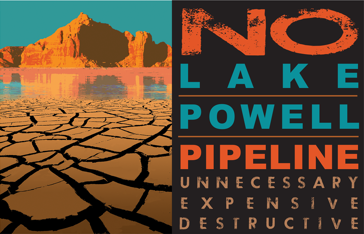Construction of the Lake Powell Pipeline threatens to leave an indelible mark on one of America’s most remote and untouched regions while syphoning a massive amount of water away from the nation’s most iconic landmark. All because some Utah water officials are eager to waste $2.24 billion of tax money.
How the Lake Powell Pipeline is Destructive
Damaging Public Resources
The remote desert lands of Southern Utah and Northern Arizona that would be bisected by the Lake Powell Pipeline represent some of the most unique lands on the planet. The region is comprised of diverse ecosystems that support endangered species of flora and fauna found nowhere else on earth.
The Lake Powell Pipeline, and its multitude of pump stations, access roads and transmission lines would scar an untouched stretch of the Paria Canyon-Vermilion Cliffs Wilderness Area. Revered by recreationists for its unobstructed views and wild quality, the remote location hosts critically endangered bird species such as the California Condor and Southwestern Willow Flycatcher.
Construction operations would severely hinder recovery efforts for several species and impact migratory birds. After construction, continued operation of pump stations, one of which is slated to operate directly adjacent to the Cockscomb Wilderness Study Area, would ensure permanent impacts from light, noise and air pollution.
The Pipeline will also impact an area used for migration and grazing by one of the most revered deer herds by hunters in the Intermountain West, the Paunsaugunt mule deer herd. Construction and increased human presence resulting from the Lake Powell Pipeline would be a direct obstacle to the herd’s annual migration and the numerous physical structures and ongoing noise and light pollution could have lasting impacts on this carefully managed wildlife population.
Diminishing Flows in the Grand Canyon
The diversion of nearly 90,000 acre-feet of water in perpetuity from the Colorado River would result in reduced flows through the Grand Canyon. Since the construction of Glen Canyon Dam, the Canyon has borne the impacts of altered flows and decreased sediment, of which 90% remains trapped behind the dam.
The Lake Powell Pipeline would threaten efforts to restore riverine habitat and endangered fish species through experimental pulse flows and accelerate erosion and habitat loss in the Canyon.
Spreading Invasive Species
The Lake Powell Pipeline will serve as an invasive species delivery system, shuttling destructive Quagga Mussels from Lake Powell to Sand Hollow Reservoir and adjacent watersheds like the Virgin River. Communities across Utah have worked tirelessly to halt the mussels’ spread, and the Lake Powell Pipeline would contaminate previously mussel-free water bodies in Southwestern Utah.
Once the invasive mussels gain a foothold within the 69-inch pipeline, they will adversely affect efficiency, as they grow inward and obstruct the pipe. Any effort to chemically eradicate the mussels within the proposed pipeline would pose a significant threat to water quality and environmental conditions. Currently, there is no chemical treatment available that eradicates 100% of Quagga mussels.
Mule deer image: Steven Earley



